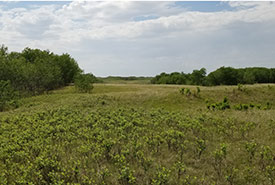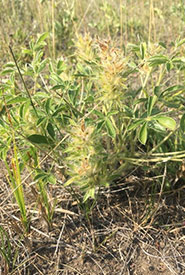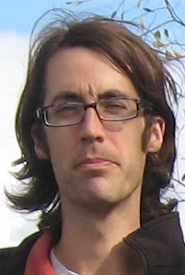It feels like I’m sending my kid to school ― grazing school

Dundurn property, SK (Photo by NCC)
So, back in July I was crashing through the bush trying to get back from the west boundary fence of the Dundurn property when I was hit with an analogy, along with a bunch of branches. I had an epiphany of how the Nature Conservancy of Canada (NCC) staff in Saskatchewan (Emily Little, Jen McKillop, Cameron Wood, Ryan Dudragne, Verity Moore-Wright, Michelle Neufeld and everyone else who helped through all the steps needed to buy a new property) are sending our baby property to school to re-learn how to be grazed like a grown-up prairie. I realize I’m on thin ice here, because if my kids ever read this they’ll wonder if the Calvin and Hobbes comics they are reading ― the one where the dad tells Calvin that he was picked from the Sears catalogue ― are true to life for them. Not that I would ever sell my kids.
NCC only just closed the Dundurn deal in early 2018, but we had been negotiating the purchase for a while before that. Anyway, I was crashing through the aspen and rose trying to blunder my way back to the truck, revealing to myself that I really am a prairie kid who needs 360 degrees of clear view not to get lost. I definitely spent a few minutes stumbling north instead of east, because it turns out that the deer trails I was following didn’t lead back to the main gate of the property, when I realized that I was going to miss the way this little patch of prairie looked ― all spiffy and free from cow poop.
I was heading back to town after meeting the new lessee of the property. The lessee and I played a quick round of full-contact Saskatchewan name-game (this is where you figure out another person who you both know). Ideally, it’s a cousin, but old teacher or equipment salesman will do in a pinch. We settled on the 90–year-old retired large animal vet from the University of Saskatchewan neither of us could remember the name of but who we both knew was short in stature and high in energy. We spent a few minutes chatting about NCC’s philosophy on grazing and how we are trying to mimic the conditions under which plants and animals of the area evolved.
I even got to meet the group of about 20 cow moms and their cow kids (pretty sure that’s the correct terminology) waiting by the lessee’s side-by-side (and by waiting, I mean licking the rugged tires of this useful and spacious all-terrain vehicle). They were curious but wary (I have yet to charm a herd). As I was walking back from the far fence, trying to hurry to prove to our new lessee that I could indeed move quickly without the aid of a side-by-side (man, I wish I had even one of those one person all-terrain vehicles I’ve heard other people have. I was so out of breath. Quads...I think they call them.), I kept seeing new species of plants I hadn’t seen on the property before and new pockets of habitat I didn’t know were there.

A late season, very fuzzy Pediomelum esculentum (breadroot or prairie turnip). (Photo by NCC)
And while I was doing this hasty bit of inventory, I was thinking that I’d probably never see the property looking like this again. The other day, a friend was asking me what the main grass was in Saskatchewan. Yes, those are the kinds of conversations I have. I did my best to explain that there are many grasses in the province and that the main one depended on location, growing conditions and the grazing history of the land.
My new favourite property (sorry Asquith North 03) will never be the same because cows have started grazing it. Some plants will start showing up more frequently and some will be less obvious. Some birds and beetles will appreciate the change and some won’t. That’s okay and good because part of our mandate at NCC is to manage our properties to suit the plants and animals and best mimic the conditions that the plants and animals of the prairie evolved around. We will keep going each year to measure and adjust for the needs of the ecosystem, and the ecosystem will keep changing.


